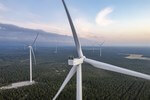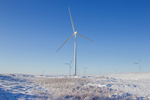10/04/2010
Saudi Arabia - Potential of 160 GW of wind power
Using its most bountiful natural resource -- the sun -- the Kingdom could by investing in solar energy reserve its oil resources for petrochemical production. And the country can be self-sufficient in and the exporter of solar power generated electricity within the foreseeable future.
The message from several speakers at the Saudi Water and Power Forum on Monday was loud and clear. Sustainable renewable energy from the sun, geothermal sources and wind power is not only possible, but also practical with current technology and essential to the Kingdom's development.
The Kingdom has until now been 100 percent reliant on fossil fuels, said Khalid Al-Sulaiman, president for Renewable Energy and the newly established King Abdullah City for Atomic and Renewable Energy (KA-CARE). However, the world is heading toward using a mix of energy resources and Saudi Arabia, with the two new centers of excellence KA-CARE and King Abdullah University of Science and Technology (KAUST), well-positioned to develop a Kingdom-based program using current and locally developed technology.
"This is not a showcase, but a vehicle where things can be translated from Saudi Arabia to the world," he said. He pointed to the summer spike of electricity consumption, some 40 percent higher than winter demand. "Renewable energy can play a great role hear," he said.
As well as sun as a power source, the Kingdom's seismically very active Western Region, concentrated in a line from Qunfudah in the south through to Jebel Abbiyad north of Madinah, was heavy with potential, according to Hani Zahran, manager of the Earthquake and Volcano unit at the Saudi Geological Survey.
"The 18,000 sq. km basaltic cover of the herrats (solidified lava fields) that spread over the Western Region indicates a very active seismicity that could be tapped," he told delegates. This he said was confirmed by the several hot springs from Al-Laith and Jazan -- which produce water from 100 degrees Celsius in the former to 130 in the latter.
However, the Kingdom has no recent record of developing on existing oil technology, said Salman Al-Jishi, vice chairman of the Industrial Committee at the Jeddah Chamber of Commerce and Industry. "We have not seen innovation or a patent in the oil sector in the last eight years," he noted adding that it was essential that the Kingdom take ownership of new developments ensuring a minimum of 40 percent local content.
He recommended a government oversight committee be set up to monitor developments.
Wind energy has long been a high-profile low-return form of energy generation. While efficient on paper, they rely on a plentiful supply of wind to generate a profit over their design life.
That said, the first step is to establish the areas where wind is sufficient in speed and continuity to make wind turbines viable. Roger Othman of the Facilities Planning Department at Aramco presented the first wind-map of Saudi Arabia. He calculated that eight percent of the country had a net wind-speed of seven meters/second -- and that this had the theoretical potential to produce 160 gigawatts a year.
The market for energy is huge, in the region of $368 billion per annum in 2008 and rising. The Saudi demand alone for energy looks set to double in the next 10 years, half of the total consumption both now and then being the domestic cooling/air conditioning market.
Ghassan Jabbour, head of Solar Development at KAUST, said it made sense to invest in renewable technologies now and develop them locally. He said that photovoltaic cells although functional were expensive to produce and maintain.
He described research under way to print the cells using newspaper-printing techniques that may well reduce the cost enormously and within five years raise their efficiency to 20 percent. However, it was the Concentrating Solar Power (CSP) method that currently dominated the market and looked set to do so for some time, especially with recent developments in the storage of collected energy as heat.
CSP uses parabolic mirrors that track the sun and concentrate its rays onto a salt-filled tube producing temperatures in excess of 600 degrees Celsius. This is used to produce steam that powers turbine generators.
Ghassan pointed out that photovoltaic collectors faced a problem with maintenance. Dust and moisture combine to settle on the collectors, considerably reducing their efficiency. "Maintenance and cleaning is the killer," he said. However, a nonstick surface coating is under development and could reduce the problem to manageable levels.
Saudi Arabia is located ideally to capitalize on the development of solar energy as it sits at the heart of the "sun belt" where sunshine is at its most intense. It was, agreed the panelists, in a favored position and had enormous potential to become a world leader in energy export.
For more information on this article or if you would like to know more about what www.windfair.net can offer, please do not hesitate to contact Trevor Sievert at ts@windfair.net
www.windfair.net is the largest international B2B Internet platform – ultimately designed for connecting wind energy enthusiasts and companies across the globe!
The message from several speakers at the Saudi Water and Power Forum on Monday was loud and clear. Sustainable renewable energy from the sun, geothermal sources and wind power is not only possible, but also practical with current technology and essential to the Kingdom's development.
The Kingdom has until now been 100 percent reliant on fossil fuels, said Khalid Al-Sulaiman, president for Renewable Energy and the newly established King Abdullah City for Atomic and Renewable Energy (KA-CARE). However, the world is heading toward using a mix of energy resources and Saudi Arabia, with the two new centers of excellence KA-CARE and King Abdullah University of Science and Technology (KAUST), well-positioned to develop a Kingdom-based program using current and locally developed technology.
"This is not a showcase, but a vehicle where things can be translated from Saudi Arabia to the world," he said. He pointed to the summer spike of electricity consumption, some 40 percent higher than winter demand. "Renewable energy can play a great role hear," he said.
As well as sun as a power source, the Kingdom's seismically very active Western Region, concentrated in a line from Qunfudah in the south through to Jebel Abbiyad north of Madinah, was heavy with potential, according to Hani Zahran, manager of the Earthquake and Volcano unit at the Saudi Geological Survey.
"The 18,000 sq. km basaltic cover of the herrats (solidified lava fields) that spread over the Western Region indicates a very active seismicity that could be tapped," he told delegates. This he said was confirmed by the several hot springs from Al-Laith and Jazan -- which produce water from 100 degrees Celsius in the former to 130 in the latter.
However, the Kingdom has no recent record of developing on existing oil technology, said Salman Al-Jishi, vice chairman of the Industrial Committee at the Jeddah Chamber of Commerce and Industry. "We have not seen innovation or a patent in the oil sector in the last eight years," he noted adding that it was essential that the Kingdom take ownership of new developments ensuring a minimum of 40 percent local content.
He recommended a government oversight committee be set up to monitor developments.
Wind energy has long been a high-profile low-return form of energy generation. While efficient on paper, they rely on a plentiful supply of wind to generate a profit over their design life.
That said, the first step is to establish the areas where wind is sufficient in speed and continuity to make wind turbines viable. Roger Othman of the Facilities Planning Department at Aramco presented the first wind-map of Saudi Arabia. He calculated that eight percent of the country had a net wind-speed of seven meters/second -- and that this had the theoretical potential to produce 160 gigawatts a year.
The market for energy is huge, in the region of $368 billion per annum in 2008 and rising. The Saudi demand alone for energy looks set to double in the next 10 years, half of the total consumption both now and then being the domestic cooling/air conditioning market.
Ghassan Jabbour, head of Solar Development at KAUST, said it made sense to invest in renewable technologies now and develop them locally. He said that photovoltaic cells although functional were expensive to produce and maintain.
He described research under way to print the cells using newspaper-printing techniques that may well reduce the cost enormously and within five years raise their efficiency to 20 percent. However, it was the Concentrating Solar Power (CSP) method that currently dominated the market and looked set to do so for some time, especially with recent developments in the storage of collected energy as heat.
CSP uses parabolic mirrors that track the sun and concentrate its rays onto a salt-filled tube producing temperatures in excess of 600 degrees Celsius. This is used to produce steam that powers turbine generators.
Ghassan pointed out that photovoltaic collectors faced a problem with maintenance. Dust and moisture combine to settle on the collectors, considerably reducing their efficiency. "Maintenance and cleaning is the killer," he said. However, a nonstick surface coating is under development and could reduce the problem to manageable levels.
Saudi Arabia is located ideally to capitalize on the development of solar energy as it sits at the heart of the "sun belt" where sunshine is at its most intense. It was, agreed the panelists, in a favored position and had enormous potential to become a world leader in energy export.
For more information on this article or if you would like to know more about what www.windfair.net can offer, please do not hesitate to contact Trevor Sievert at ts@windfair.net
www.windfair.net is the largest international B2B Internet platform – ultimately designed for connecting wind energy enthusiasts and companies across the globe!
- Source:
- Online Editorial, www.windfair.net
- Author:
- Posted by Trevor Sievert, Online Editorial Journalist
- Email:
- ts@windfair.net
- Link:
- www.windfair.net/...
- Keywords:
- wind energy, wind power, wind turbine, onshore, offshore, windmill, www.windfair.net, Trevor Sievert, ECA


























